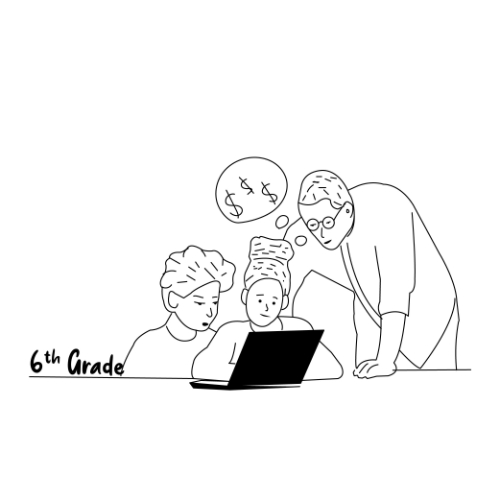If you are a 6th-grade teacher looking for money activities and games to hook your students, you have come to the right place. In this guide, we will dive into the best supplemental exercises for learners at this level. While nothing will replace your core lessons, games, online activities, and downloadable worksheets are fantastic additions to your financial education curriculum. Before we jump into it, check out our 6th grade money lesson plans page to find all the core lesson plans you need to teach your 6th-graders’ financial education!
According to the Federal Reserve Bank of Kansas City, 6th-grade teachers should cover essential topics like shortage, surplus, finance, circular flow, exchange rate, standard of living, and economic systems through the lens of global trade. The best lessons often tie in advanced math skills and economic principles to give the best foundation for this level of learning. However, math is becoming steadily more complex for your students. The games below focus on improving your kids’ mathematical abilities and money knowledge through a fun approach that will keep them coming back for more!
Online Games and Activities
Your students love playing games and interacting with websites, and many of our top activities involve these aspects. You can find games that challenge and those that help build up students who are behind, making them perfect for all students in your room. Teachers can assign these games as an independent review, partner work, or in centers and stations around the room.
The Biggest Bang for Your Buck
Many 6th-graders enjoy going to the mall, and this game capitalizes on that interest as your students wander through different stores and spend efficiently. Kids get shopping bags, fill them up with various products, compare prices of other items, and find deals that help them spend smartly.
Consumer Math: Unit Prices
Your students’ math skills are improving, and operations become more challenging as they move into middle school and beyond, and this game requires kids to think on multiple levels. They face various word problems with realistic situations and need to figure out how much individual items cost in larger sets. Kids will face these problems in stores and need to know how to recognize the better deal in stores, making this activity practical and valuable.
Unit Prices with Customary Unit Conversions and Fractions
This game steps up the difficulty level of the unit prices activity, requiring learners to perform multiple steps to solve the problems. They will find word problems about money that also assess their conversion between different units, helping them become savvy shoppers in the future.
Which is the Better Coupon?
If you need a game where students face real-life money problems, you will enjoy assigning this activity to your 6th-graders. They choose between two coupons at a time, deciding which is the better deal based on discount percentages and types of savings.
Sale Price
In this interactive activity, students face many problems they would likely see in a retail store or online seller. Your kids need to figure out the price they would pay after the advertised discount is applied to the cost, making this another practical exercise for them to work on and learn.
Sale Prices: Find the Original Price
Finding the original price of an item is challenging, as kids need to work backward and use different operations to get to the correct solution. Your 6th-grade students are working on pre-algebra and basic algebraic skills, and this is an excellent activity to combine your money education with these advanced strategies.
Calculate Tip, Markup, and Commission
Part of the 6th-grade money education curriculum is the various ways to earn income, including salary, tips, and commissions, and this exercise dives deeper into the lessons you go over with your kids. Students will face word problems where they need to determine how much of a tip to leave in a hypothetical restaurant situation or find the bill’s total after you pay the bonus.
Cash Out
This popular game is ideal for 6th-grade students, but teachers can adapt it to many grade levels. It is a tremendous individual exercise for counting money and making change from a virtual cash register, combining many elements of your money education approach into one fun game your students will love.
Lunch Lady
This game works for 4th-6th-graders, as teachers can adjust the variables to make it work for any of those levels, and your students will enjoy the storyline behind the gameplay. Their job is to keep the lunch lady from losing her patience by calculating the proper change as quickly as possible before the next wave of energetic students enters the cafeteria.
Coin Search
Your students will like playing this online game, as it has fun gameplay, exciting graphics, and a word search feel that will engage kids. It works exceptionally well as a review tool because the game assesses skills students learned in 5th grade but need to solidify to excel in 6th grade, making it perfect for struggling students or those who want to brush up on coin value and add money quickly.
Money Tree
Thanks to its unique approach to money awareness, you can trust this game to interest your students, as kids pick coins from a tree and quickly need to determine values. The activity is entirely customizable and will work to hammer home your lessons about coin denominations, and it provides instant feedback so your kids can see what they are doing correctly or not.
Tipster
Your 6th-graders are further on their way to financial independence than many of them realize, including going to restaurants and figuring out how to pay the check. This game steps it up another level, putting students in the role of a restaurant manager who needs to figure out how much to pay his workers by looking at percentages and quality of service.
Hands-On Activities
Downloadable worksheets and printable activities are other exceptional approaches to bolstering your money education lessons. These exercises will reinforce critical skills your 6th-grade students learn throughout the school year.
Unit Prices: Which is the Best Deal?
This worksheet is ideal for partners or small groups, where they work together to solve unit price problems and determine the best deals. It introduces authentic situations, like finding the best way to buy specific products: by the dozen, in bulk, or individually. Students calculate and decide the ideal solution to save the most money as they go through the worksheet.
Shopping Word Problems
Teachers benefit their students by exposing them to real-world situations, and this worksheet gives them prices and products they will likely run into soon. Kids will see a list of delicious items – hot dogs, cheeseburgers, sodas, and French fries – and need to determine which items they can afford with their money.
Saving with a Purpose!
If you need an activity that will span months of the year but can continuously reinforce what you are going over in class, this one will be a winner. Kids partner up and form a club, design a plan to save money for six months, and decide where to donate the money. This activity reinforces many skills, including saving and how to donate to specific causes.
The 52-Week Money Challenge for Kids
Teachers can customize this extensive activity to different time frames, although you can stretch it for up to a year. It involves students planning, saving, and earning income for hard work, and they have to balance their registers by showing the deposits and withdrawals they make throughout the activity.
Whoa! Where Did My Allowance Go?
Money management is a crucial skill for kids and adults alike, and the earlier they start to develop good habits, the better. In this downloadable hands-on activity, partners take turns moving through the game board, gauging where all their hard-earned money goes, learning how careful spending is essential for financial success – and winning this game!
Build Your Own Pretend ATM
This activity combines financial education with good old-fashioned craftsmanship, where students make a model ATM out of cardboard. The end product actually works, as users can swipe the reader and retrieve money from the machine, giving kids pride in their creations and showing students how these transactions work.
Accountability Binders
One primary goal of money education is to instill responsible habits in money management and keep kids accountable for their decisions. In this elaborate activity, students need to track their transactions, save receipts, and more (it is entirely customizable, and you can use real or pretend money), keeping them on the path to financial success.
United States-Canada Exchange Rates – Math Challenge
Your 6th-graders learn about exchange rates; this worksheet is an excellent way to show them specific examples of how it all works. They need to convert between American and Canadian currencies and vice versa, giving them hands-on experience and practice in this valuable skill.


